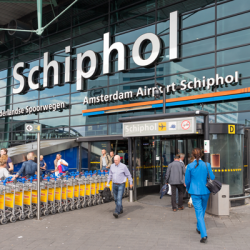Amsterdam Airport Schiphol to introduce new noise reduction measures
In partnership with LVNL, Amsterdam Airport Schiphol has developed a joint programme of measures to reduce noise emissions caused by air traffic.
List view / Grid view


Schiphol Airport is the main airport in the Netherlands and is approximately twenty minutes from Amsterdam city centre by train.
It is the third busiest airport in Europe in terms of passenger traffic. The airport has six runways and one passenger terminal which is divided into three departure areas.
Built on what was once a large lake, Schiphol Airport is one of the world’s lowest airports, lying three metres below sea level.
In partnership with LVNL, Amsterdam Airport Schiphol has developed a joint programme of measures to reduce noise emissions caused by air traffic.
Numerous airports - including Amsterdam, Bristol, Birmingham and Keflavik - have shifted from single-process queue measurement to airport-wide flow management, to help improve resourcing, expansion planning and prevent bottlenecks. We spoke to James Williamson, CEO of Veovo, to learn about the benefits of seamless passenger insights.
In 2019, Airport Carbon Accreditation marked its 10th anniversary. Marina Bylinsky, Head of Sustainability at ACI EUROPE, evaluates the progress made by airports across the globe in regard to climate emergency.
Through its CEO series, International Airport Review spoke to Graham Millett, CEO of Western Sydney International, about how the airport is set to be a disruptor in Australian aviation.
The programme will aim to decrease nitrogen oxide emissions from Schiphol Airport, in keeping with its emission-free 2030 target.
The partnership will see Amsterdam Airport Schiphol help find employment for 750 beneficiaries who need additional support.
Dr. Atsushi Iwata, VP of NEC’s Safer City Solutions Division, explains how biometric services can play a key role in creating a better end-user experience for air passengers.
On the subject of virtual reality (VR) and augmented reality (AR), video games and gadgets come to mind. Yet this technology can be used in many more ways and places, including airports, said Laurens van Oostendorp, Service Manager and Transformation Manager within the IT department of Royal Schiphol Group.
The investment will be utilised to increase capacity in order to accommodate the growing number of public transport passengers.
Dallas/Fort Worth and Winnipeg Richardson airports are to trial autonomous personal EVs to aid passengers with reduced mobility.
Intelligent Approach, the air traffic control system that dynamically separates arrivals by time instead of distance, is in the first phase of being deployed at Schiphol to help improve tactical capacity and operational resilience.
The first IoT application at Schiphol involves the option for passengers to share real-time feedback regarding their experiences in the toilet facilities.
An air traffic control system that dynamically separates arrivals by time instead of distance is being deployed at Schiphol.
For airports across the globe, providing passengers with a seamless travel experience whilst protecting the airport systems from risks are two of the most important priorities. Here, Wilma van Dijk gives an insight into how Schiphol is working towards securing both.
Official Airline Guide has released its annual Megahubs Index in which it rates the connectivity of major air transportation hubs.